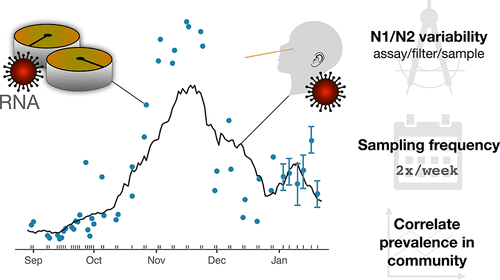当前位置:
X-MOL 学术
›
ACS ES&T Water
›
论文详情
Our official English website, www.x-mol.net, welcomes your feedback! (Note: you will need to create a separate account there.)
Evaluation of Sampling, Analysis, and Normalization Methods for SARS-CoV-2 Concentrations in Wastewater to Assess COVID-19 Burdens in Wisconsin Communities
ACS ES&T Water Pub Date : 2021-07-09 , DOI: 10.1021/acsestwater.1c00160 Shuchen Feng 1 , Adelaide Roguet 1 , Jill S. McClary-Gutierrez 1 , Ryan J. Newton 1 , Nathan Kloczko 2 , Jonathan G. Meiman 2 , Sandra L. McLellan 1
ACS ES&T Water Pub Date : 2021-07-09 , DOI: 10.1021/acsestwater.1c00160 Shuchen Feng 1 , Adelaide Roguet 1 , Jill S. McClary-Gutierrez 1 , Ryan J. Newton 1 , Nathan Kloczko 2 , Jonathan G. Meiman 2 , Sandra L. McLellan 1
Affiliation

|
Wastewater surveillance for SARS-CoV-2 provides an approach for assessing the infection burden across a sewer service area. For these data to be useful for public health, measurement variability and the relationship to case data need to be established. We determined SARS-CoV-2 RNA concentrations in the influent of 12 wastewater treatment plants from August 2020 to January 2021. Technical replicates for N1 gene concentrations showed a relative standard deviation of 24%, suggesting it is possible to track relatively small (∼30%) changes in SARS-CoV-2 concentrations over time. COVID-19 cases were correlated significantly (ρ ≥ 0.70) to wastewater SARS-CoV-2 RNA concentrations across large and small service areas, with weaker relationships (ρ ≥ 0.59) in two communities. SARS-CoV-2 concentrations normalized to per capita slightly improved correlations to COVID-19 incidence, but normalizing to a spiked recovery control (BCoV) or a fecal marker (PMMoV or HF183) reduced correlations for a number of plants. Daily sampling demonstrated that a minimum of two samples collected per week were needed to maintain accuracy in trend analysis. The differences in the strength of SARS-CoV-2 relationships to COVID-19 incidence and the effect of normalization on these data among communities demonstrate that rigorous validation should be performed at individual sites where wastewater surveillance programs are implemented.
中文翻译:

评估废水中 SARS-CoV-2 浓度的采样、分析和标准化方法,以评估威斯康星州社区的 COVID-19 负担
SARS-CoV-2 的废水监测提供了一种评估整个下水道服务区感染负担的方法。为了使这些数据对公共卫生有用,需要建立测量变异性和与病例数据的关系。我们确定了 2020 年 8 月至 2021 年 1 月期间 12 个污水处理厂进水中的 SARS-CoV-2 RNA 浓度。N1 基因浓度的技术重复显示相对标准偏差为 24%,这表明可以追踪相对较小的(~30 %) SARS-CoV-2 浓度随时间的变化。COVID-19 病例与大型和小型服务区的废水 SARS-CoV-2 RNA 浓度显着相关(ρ ≥ 0.70),两个社区的相关性较弱(ρ ≥ 0.59)。SARS-CoV-2 浓度标准化为人均略微改善了与 COVID-19 发病率的相关性,但标准化为尖峰恢复控制 (BCoV) 或粪便标记物 (PMMoV 或 HF183) 降低了许多植物的相关性。每日采样表明,每周至少需要收集两个样本才能保持趋势分析的准确性。SARS-CoV-2 与 COVID-19 发病率之间关系的强度差异以及标准化对社区之间这些数据的影响表明,应在实施废水监测计划的各个地点进行严格的验证。每日采样表明,每周至少需要收集两个样本才能保持趋势分析的准确性。SARS-CoV-2 与 COVID-19 发病率之间关系的强度差异以及标准化对社区之间这些数据的影响表明,应在实施废水监测计划的各个地点进行严格的验证。每日采样表明,每周至少需要收集两个样本才能保持趋势分析的准确性。SARS-CoV-2 与 COVID-19 发病率之间关系的强度差异以及标准化对社区之间这些数据的影响表明,应在实施废水监测计划的各个地点进行严格的验证。
更新日期:2021-08-13
中文翻译:

评估废水中 SARS-CoV-2 浓度的采样、分析和标准化方法,以评估威斯康星州社区的 COVID-19 负担
SARS-CoV-2 的废水监测提供了一种评估整个下水道服务区感染负担的方法。为了使这些数据对公共卫生有用,需要建立测量变异性和与病例数据的关系。我们确定了 2020 年 8 月至 2021 年 1 月期间 12 个污水处理厂进水中的 SARS-CoV-2 RNA 浓度。N1 基因浓度的技术重复显示相对标准偏差为 24%,这表明可以追踪相对较小的(~30 %) SARS-CoV-2 浓度随时间的变化。COVID-19 病例与大型和小型服务区的废水 SARS-CoV-2 RNA 浓度显着相关(ρ ≥ 0.70),两个社区的相关性较弱(ρ ≥ 0.59)。SARS-CoV-2 浓度标准化为人均略微改善了与 COVID-19 发病率的相关性,但标准化为尖峰恢复控制 (BCoV) 或粪便标记物 (PMMoV 或 HF183) 降低了许多植物的相关性。每日采样表明,每周至少需要收集两个样本才能保持趋势分析的准确性。SARS-CoV-2 与 COVID-19 发病率之间关系的强度差异以及标准化对社区之间这些数据的影响表明,应在实施废水监测计划的各个地点进行严格的验证。每日采样表明,每周至少需要收集两个样本才能保持趋势分析的准确性。SARS-CoV-2 与 COVID-19 发病率之间关系的强度差异以及标准化对社区之间这些数据的影响表明,应在实施废水监测计划的各个地点进行严格的验证。每日采样表明,每周至少需要收集两个样本才能保持趋势分析的准确性。SARS-CoV-2 与 COVID-19 发病率之间关系的强度差异以及标准化对社区之间这些数据的影响表明,应在实施废水监测计划的各个地点进行严格的验证。


























 京公网安备 11010802027423号
京公网安备 11010802027423号